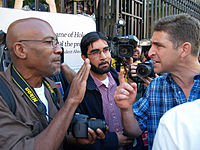
Photo from wikipedia
The key problems of dynamic hand gesture recognition are large intra-class (gesture types, without considering hand configuration) spatial-temporal variability and similar inter-class (gesture types, only considering hand configuration) motion pattern.… Click to show full abstract
The key problems of dynamic hand gesture recognition are large intra-class (gesture types, without considering hand configuration) spatial-temporal variability and similar inter-class (gesture types, only considering hand configuration) motion pattern. Firstly, for intra-class spatial-temporal variability, the key is to reduce the spatial-temporal variability. Due to the average operation can improve the robustness very well, we propose a motion pattern descriptor, Time-Wise Histograms of Oriented Gradients (TWHOG), which extracts the average spatial-temporal information in the space-time domain from three orthogonal projection views (XY, YT, XT). Secondly, for similar inter-class motion pattern, accurate representation of hand configuration is especially important. Therefore, the difference in detail needs to be fully captured, and the shape descriptor can amplify subtle differences. Specifically, we introduce Depth Motion Maps-based Histograms of Oriented Gradients (DMM-HOG) to capture subtle differences in hand configurations between different types of gestures with similar motion patterns. Finally, we concatenate TWHOG and DMM-HOG to form the final feature vector Time-Shape Histograms of Oriented Gradients (TSHOG) and verify the effectiveness of the connection from quantitative and qualitative perspective. Comparison study with the state-of-the-art approaches are conducted on two challenge depth gesture datasets (MSRGesture3D, SKIG). The experiment result shows that TSHOG can achieve satisfactory performance while keeping a relative simple model with lower complexity as well as higher generality.
Journal Title: Multimedia Tools and Applications
Year Published: 2018
Link to full text (if available)
Share on Social Media: Sign Up to like & get
recommendations!